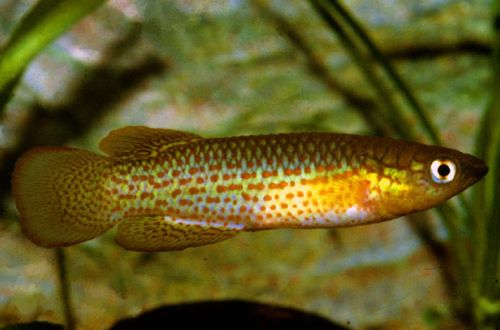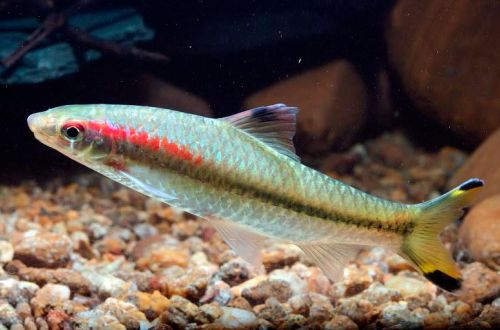
Playfer’s panhax
Panhax Plyifera, scientific name Pachypanchax playfairii, belongs to the Aplocheilidae family. A tropical original rainbow fish from the Seychelles, it is large in size compared to other Killies. Quite unpretentious, easy to maintain and breed.

Contents
Habitat
Endemic to the Seychelles, east coast of the African continent just above Madagascar. Wild populations are found in particular on Mahe, Praslin, Silhouette and La Digue. The islands are covered with tropical rain forest in the shade of which numerous streams and streams flow – the habitats of this species.
Description
Adults reach 10 cm in length, males are larger than females and have a brighter color. The body has a grayish color, but depending on the lighting, shades of green and yellow appear. The pattern consists of numerous red dots stretching from head to tail. Rounded fins are also decorated with dark and light green dots.
Food
In nature, it belongs to carnivorous species, the basis of the diet consists of small insects, crustaceans and worms. In a home aquarium, it is desirable to feed foods rich in protein components, such as dried or frozen bloodworms, daphnia, insect larvae, as well as similar live foods, including small worms, fruit flies, mosquitoes, etc.
Maintenance and care
A group of 3-4 individuals will require an aquarium of at least 120 liters. The design uses numerous shelters in the form of intertwined roots and branches of trees, imitating natural habitats. A substrate of coarse sand or small pebbles with rock fragments. Plants any, located in groups along the side and rear walls of the tank, to maintain a free central area for swimming. Floating plants are welcome, but they should not be allowed to overgrow the entire surface of the water.
The minimum required set of equipment consists of filtration, lighting and heating systems. When choosing a filter, give preference to the most productive systems that are within your means, since Plyifer Panhaks live in running clear waters and do not respond well to excessive pollution. The water streams coming out of the filter should be directed towards the glass or large design objects in order to prevent a strong internal current.
Permissible water parameters vary from slightly acidic to slightly alkaline, hardness is also in a wide range, so there are no difficulties with water treatment, it is enough to let it settle and can be added to the aquarium. More about pH and dGH parameters in the section “Hydrochemical composition of water”.
Maintenance is reduced to a weekly renewal of part of the water by 10–15% of the volume and periodic cleaning of the glass from plaque, and the soil from accumulated organic waste.
Behavior and Compatibility
Relatively peaceful, but in some cases, pursuit of smaller fish is possible. It is preferable to keep either with members of its own species, or with peaceful fish of a similar or slightly larger size.
Intraspecific relationships are built on the dominance of the alpha male, who will constantly arrange battles with competitors to maintain his status. Although such skirmishes rarely result in serious damage, it is nevertheless recommended to keep one male in the company of several females.
Breeding / breeding
Panhaxes do not show parental instincts to take care of their offspring and will often eat their own fry. To achieve the result, spawning should be carried out in a separate tank, which is designed in a similar way as the main aquarium, with the exception of plants. The basis of the vegetation cover consists of various aquatic mosses (Javanese moss, Riccia, etc.), where the fish lay their eggs. Of the equipment, a simple sponge filter, heating and lighting systems are sufficient. Read more about spawning and subsequent care of offspring in the Breeding of fish section.
Fish diseases
Suitable housing conditions and a balanced diet directly determine the well-being of the fish. In a mature aquarium with a well-established biological system, health problems do not arise.





